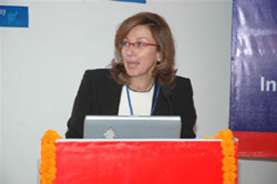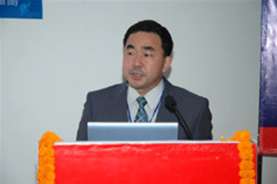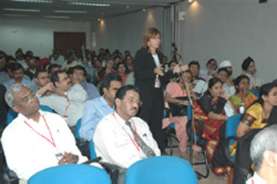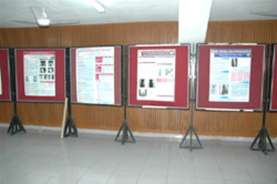
1st National Conference of ISBMR, November 10, 2005, Delhi
“Symposium on Metabolic Bone Disorders”, the title of the first Annual Conference of The Indian Society for Bone and Mineral Society was held at All India Institute of Medical Sciences on 10th November 2005. The symposium was supported and acknowledged by International Osteoporosis Foundation, Geneva, the leading world known organization, which is dedicated to fight against osteoporosis.
This one-day event was attended by more than one hundred and fifty delegates, which included specialists from the field of endocrinology, gynecology and orthopedics.
The faculty members comprised of endocrine and osteoporosis specialists from all over India and abroad:-
• Dr. Ghada El-Hajj Fuleihan-Lebanon
• Dr Akira Itabashi-Japan
• Dr M F Holic-USA
• Dr Subhash Kukreja-USA
• Dr D Sudhaker Rao-USA
• Dr Daniel Thiebaud-Australia
• Dr Manoj Chadha-Mumbai
• Dr Ravinder Goswami-Delhi
• Dr Sushil Gupta-Lucknow
• Dr. Urvashi Jha-Delhi
• Dr Raman Marwaha-Delhi
• Dr Ambrish Mithal-Delhi
• Dr Uma Ravishankar-Delhi
• Dr Nikhil Tandon-Delhi
• Dr Usha Sriram-Chennai
The scientific program was tailor made with the topics like bone remodeling in health & disease, vitamin D status in Indians, treatment of osteoporosis, SERMS and calcitonin, bisphosphonates – recent advances and practical issues in bone densitometry.
Dr Ambrish Mithal, President of ISBMR, welcomed the delegates and started the conference with opening remarks on the objectives of The Indian Society for Bone and Mineral Research and talked about the spreading awareness of osteoporosis through physician education and general public. Then he invited Mrs. Wilson who is 78years old and suffering from osteoporosis for the last 20 years to share her experiences & views with the audience.
The morning session was on “Pathophysiology of Osteoporosis” and the first talk of this sessions was delivered by D Sudhaker Rao-USA, on “Bone remodeling in health and disease: new insights” saying that although skeletal homeostasis and mineral homeostasis appear to be independent of each other, they are in reality closely interrelated and interdependent. Negative calcium balance will lead to bone loss and bone fractures, and conversely, adequate calcium nutrition maintains bone strength and integrity With the advent of bone densitometers, cellular mechanisms responsible for bone loss have taken a back seat, but bone density contributes only 30-35% or so for osteoporotic fracture syndrome.
Thorough understanding of bone biology, skeletal homeostasis, and their intimate intricate relationships to bone and mineral metabolism in general and mineral homeostasis in particular, is essential for clinical practice of osteoporosis.
This was followed by a talk on “Nutrition and osteoporosis” by Dr Ghada El-Hajj Fuleihan from Lebanon who elaborated on the rational and potential use and impact of nutrition on bone health. She said that normal variations in dietary protein may affect bone health; low protein intake seems to be associated with bone loss, whereas high protein intake maintains BMD in elderly persons. Protein intake promotes bone health through effects on the IGF1 axis increasing BMD and a direct effect on muscle, the latter also maintaining BMD and also reducing falls and therefore fracture risk.
A second session was on “The Asian Scene” and first talk of this session was delivered by Dr Akira Itabashi from Japan, who informed the delegates about current status of Osteoporosis in Japan. After a comprehensive review of literature he concluded his talk by showing his trials and their results done in Japan on the patient of Osteoporosis.
Next talk was also on current Indian scenario of Osteoporosis and detailed review of trials done by Dr K M Prasanna, Bangalore. Next talk was on “Vitamin D Status in Indians” by Dr Raman Marwaha, Delhi, saying that high prevalence of clinical and biochemical hypovitaminosis D and low BMD in Indians especially from poorer sections of the society suggests that nutrition plays an important role in causation of hypovitaminosis D.
The afternoon session was on “Professor MMS Ahuja Memorial Lecture” and the talk on “Vitamin D for optimal Health” was delivered by Dr M F Holick, Boston.
The fourth session was on “treatment of Osteoporosis” and first talk of this session on “SERMS and calcitonin: current status” was delivered by Dr Subhash Kukreja from USA. This talk was followed by Dr D Sudhaker Rao on the topic “ Bisphosphonates: resent advances”. He explained in details about the Bisphosphonate therapy in various metabolic bone disorders. He said that with the discovery of bisphosphonates’ avidity to the skeleton, the therapeutic horizon for managing osteoporosis has become much easier.
The first generation bisphosphonates (etidronate and clodronate) were initially developed for the treatment of Paget’s disease of bone and were later found to be effective also in preventing age-related bone loss and osteoporotic fractures. Only alendronate and risedronate are currently approved for clinical use in osteoporosis. Other related compounds, pamidronate, ibandronate, and zolidronate, are also used in certain circumstances. Despite poor gastrointestinal absorption, long biologic half-life and skeletal avidity make them ideal drugs for osteoporosis management.
Dr Daniel Thiebaud from Sydney, delivered the next talk on “New and emerging therapies” from Sydney.
After evening tea break, a session on “Practical Issues in Bone Densitometry” was discussed between eminent moderators and panelists like Dr Subhash Kukreja, Dr Uma Ravishanker, Dr Akira Itabashi, Dr Ghada Fuleihan and Dr D Sudhaker Rao.
The symposium was concluded by closing remarks of the faculty and vote of thanks by Dr Nikhil Tandon.
There was an active participation of delegates through out the day in the form of discussions on various problems and queries encountered by them in day-to-day practice.
Poster and oral presentation was also performed during the conference by the participants from all over India and was published in the conference proceeding book.





